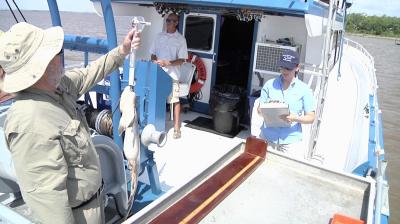Southern Miss Researchers Work to Monitor Gulf Coast Shark Population
Fri, 08/08/2014 - 02:32pm | By: Nikki Smith

A research team at The University of Southern Mississippi has spearheaded a shark monitoring program to help maintain the population of the ocean predator that is essential to the Gulf Coast ecosystem.
This catch, tag and release program conducted by the Southern Miss Gulf Coast Research Laboratory has been in place for over a decade, taking day-long expeditions into the Gulf Coast waters to catch and record information on each shark.
The team takes inventory of where large populations of shark are living along with their health and reproductive habits.
“Those really are important components that go into a stock assessment to make sure the populations are maintained and in turn maintain the populations of fish that our area fisheries rely on,” said Jill Hendon, senior research scientist at the Center for Fisheries Research and Development.
Hendon says sharks are extremely important to the local ecosystem because they will feed on the most abundant species in the area, which keeps many of the baitfish populations in check and increases overall species diversity for the region.
As sharks also often feed on the dead or dying organisms in the waters, they aid in keeping the Gulf Coast waters clean.
“These sharks are integral to maintaining the health of our ecosystem as well as the intricate balance of the food web,” Hendon said.
Hendon said the largest misconception about sharks is that they are mindless eaters.
“While many sharks are opportunistic feeders they definitely have preferred items in their diet,” Hendon said. “Most sharks are piscivorous (fish eating), while others also target invertebrates like squid and crabs for their prey. Humans are not on their menu. The instances of ‘attacks' on humans are typically cases of misidentification.”
The team works monthly from March to October in both the Mississippi Sound and just south of the Mississippi barrier islands to monitor species distribution and abundance. Each month they conduct six days of sampling with four gillnet days and two longline days.
The gillnet project involves monitoring eight gillnet stations each month in the Mississippi Sound. This method passively catches sharks in the area with the bait that would target "hungry" sharks. The bottom longline sampling features six stations monthly. This protocol involves fishing numerous circle hooks baited with Atlantic mackerel at each site.
A majority of the sharks are caught in May and June. Approximately 800-1,000 sharks are caught during each project yearly and 50 percent of them are tagged.
“We may get 20 sharks per set,” said Jeremy Higgs, a graduate student shark lab researcher. “Everything we catch and release for future work and hopefully fishermen will turn them back in and we'll know what all the sharks been doing.”
Hendon said they have a very low recapture rate, which is due in large part to the fact that the public or commercial and recreational fishermen are concerned that they did something wrong by catching a tagged fish which is not the case.
“The commercial fishermen and the recreational fishermen too — if they're aware and capture a fish with our tag in it, we love it when they give us a call,” Hendon said. “We will give them a recapture report with a map showing where all the fish has moved. Really trying to get the public involved in our science as well.”
All tags have a unique identifier number as well as Hendon's phone number on them. The research team asks that any anglers that catch a tagged fish write down this identifier number, and make note of the species, sex, length of the fish, date of the catch and GPS location of the catch.
“We have had recaptures of sharks that were at large anywhere from one day to seven years,” Hendon said. “Every recapture is exciting to look into to see what kinds of movements are revealed by that particular fish.”
The gillnet portion of the monitoring is funded by The US Fish and Wildlife Service's Sportfish Restoration Program through a collaborative effort with the Mississippi Department of Marine Resources funds the gillnet portion of the research, while Southeast Area Monitoring and Assessment Program funds the bottom long-line monitoring.